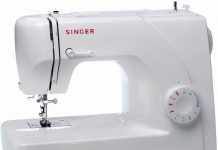As a very first sewing project, there’s nothing easier or cheaper than sewing placements and napkins. You don’t have to spend a fortune on expensive fabrics. There are no tricky sewing techniques to keep in mind or complicated patterns to fit. It’s simple, straightforward, easy and hardly takes any time at all. Moreover, sewing your own placemats and napkins allows novice sewers to get ample practice with getting the stitches in a straight line when machining.
For most beginners, machining in a straight line is the trickiest part of getting a handle on machining. It’s one thing to read all the theory you can on sewing but it’s only with a lot of practice that you can actually master this crucial machining technique and what better way to start than with simple rectangular shapes. The techniques required for sewing placemats and napkins are the same. The only differences lie in their sizes and the kind of fabric used.
Size & Fabric Requirements for Rectangular Placemats
Standard placemats measure about 18” x 14”. Of course, this size is not written in stone so feel free to adapt it to your requirements. You may want to sew smaller versions to fit on a smaller dining table or bigger placemats if your plates are unusually large.
Sturdy fabrics of medium thickness work best for placemats. Avoid very lightweight, shifty fabrics as these can be very inconvenient for the purpose.
Size & Fabric Requirements for Napkins
Standard napkins are square shaped with each of the sides measuring16”. You can make them slightly smaller if need be but avoid making them larger than 16”square or they will look and feel just too big and bulky.
Medium weight fabrics that are absorbent work best for napkins. The fabric should not be as sturdy as the one you will use for your placemats. It should be softer so your napkins can be used for the purpose they are meant.
When choosing colors, you can either go with matching table mats and napkins or choose them in complementary colors.
How to Sew the Placemats & Napkins
Whatever measurements you choose to go with, you will need to cut at least ½” outside the measurement marking for the hemming. After you’ve got all your place mats and napkins cut out, iron them out while pressing down on the edges to create a hem. This is necessary to get a clean finish and straight lines.
Once you’ve got all your hems neatly pressed, it’s time to get machining. While stitching the sides is straightforward, it is important to be extra careful when you’ve reached the corners so that you get a clean and smooth continuous stitch. To get this, when you reach a corner, lift the presser foot with the needle still in the fabric. Swivel the fabric ninety degrees, put the presser foot down and sew the next side. When you’ve finished hemming the fourth side, do a few back stitches and end off. Trim off the threads neatly and you’re done!
Adding Details to Your New Creations
Why stop now! If you have an embroidery machine, go right on ahead and use it to add details to your new creations. If you are planning on gifting the napkins and table mats, you could monogram the initials of the recipient or perhaps embroider a theme befitting the occasion such as Christmas, Valentine’s Day or Thanksgiving.
That’s it! You’re all done. Time for you to sit back and admire your first project on your sewing machine.






